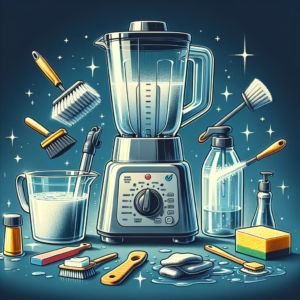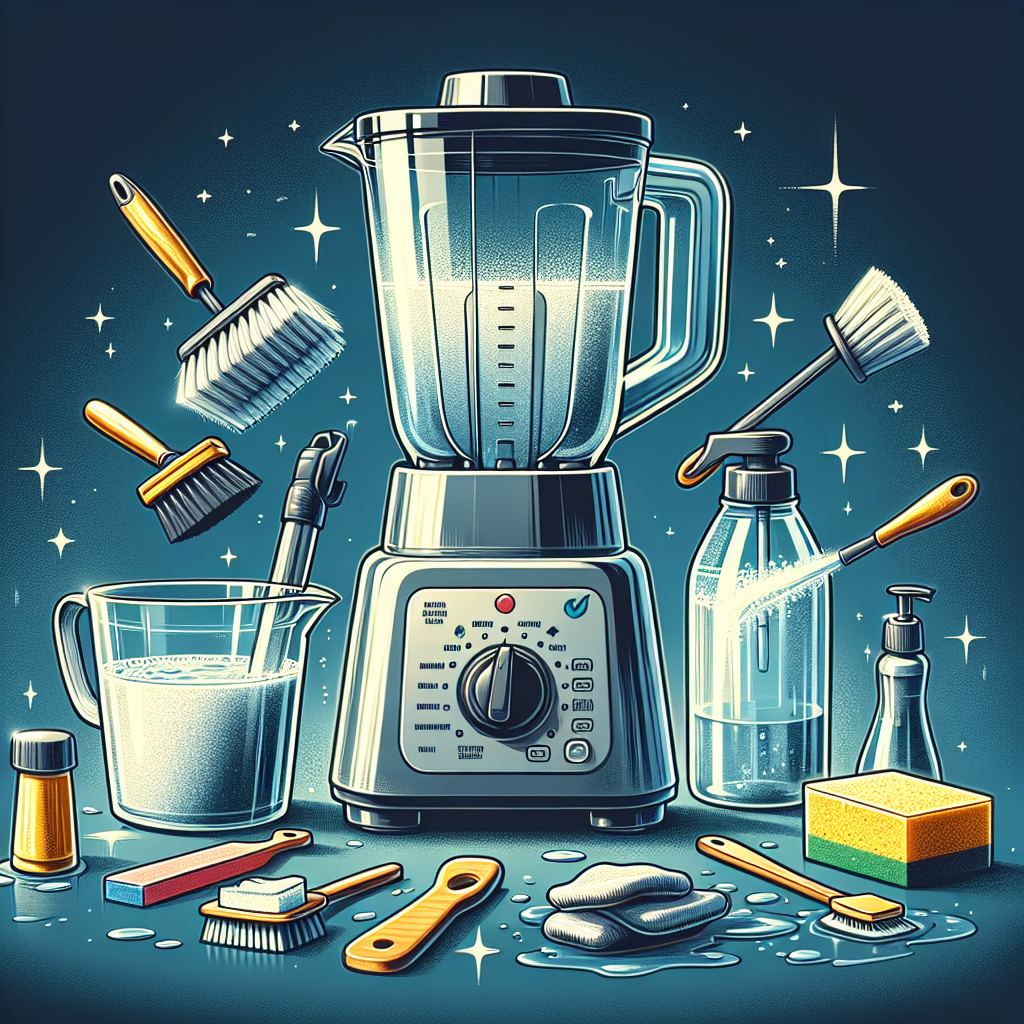How Do I Clean And Care For A Blender With A Glass Pitcher?
November 20, 2023

So, you’ve just purchased a blender with a glass pitcher, and now you’re wondering how to properly clean and care for it. Well, fret not! In this article, we’ll guide you through the simple steps to keep your blender sparkling clean and operating at its best. From tackling stubborn stains to maintaining the blades, we’ve got all the tips and tricks for you. Say goodbye to smudges and hello to a spotless blender that will continue to serve you delicious smoothies and soups for years to come. Let’s get started!

Cleaning the Glass Pitcher
Rinsing out the pitcher
To start cleaning your glass pitcher, fill it with warm water and a few drops of dish soap. Swirl the mixture around and use a soft sponge or brush to gently scrub the inside of the pitcher. Pay special attention to any areas with visible stains or residue. Once you’ve thoroughly cleaned the inside, pour out the soapy water and rinse the pitcher with clean water to remove any remaining soap.
Removing stubborn stains
If you have stubborn stains that won’t come off with just soap and water, you can try using a baking soda paste. Mix equal parts baking soda and water to create a thick paste. Apply the paste to the stained areas and let it sit for a few minutes. Then, use a soft cloth or sponge to scrub the stains. Rinse the pitcher thoroughly afterward to remove any residue. If the stains still persist, you can also try using white vinegar or lemon juice to help break them down.
Cleaning the lid and blade assembly
To clean the lid and blade assembly, remove them from the pitcher and wash them separately. You can rinse them with warm soapy water and scrub away any residue or stains using a brush or sponge. Be careful when handling the blade assembly to avoid any accidental cuts. Rinse both the lid and blade assembly with clean water and let them air dry before reassembling them onto the pitcher.
Cleaning the Base of the Blender
Unplugging the blender
Before cleaning the base of the blender, make sure it is unplugged from the power source to avoid any electrical accidents. Safety should always be a priority when dealing with electrical appliances.
Removing any food particles
To remove any food particles or residue from the base of the blender, use a soft brush or cloth to wipe it down. Pay attention to all the crevices and hard-to-reach areas. If there are any stubborn stains, you can use a mild cleaning solution or a mixture of vinegar and water to help break them down. Just make sure to wipe away the cleaning solution thoroughly and dry the base before plugging it back in.
Wiping down the surface
After removing any food particles and stains, wipe down the surface of the base with a clean, damp cloth. This will remove any remaining residue or cleaning solution. Make sure to dry the base completely before using the blender again to prevent any electrical issues.
Cleaning the Controls and Cord
Cleaning the control panel
To clean the control panel, start by making sure the blender is unplugged. Use a soft cloth or sponge dampened with water or a mild cleaning solution to gently wipe down the control panel. Be careful not to get any liquid into the control panel, as this can cause damage. Dry the control panel thoroughly before plugging the blender back in.
Cleaning the cord
The cord of the blender can easily accumulate dust and dirt, so it’s important to keep it clean as well. Use a clean cloth or a damp cloth with a mild cleaning solution to wipe down the cord. Make sure to wring out the cloth well to avoid excessive moisture. Once the cord is clean, let it air dry completely before storing or using the blender again.
Caring for the Glass Pitcher
Avoiding extreme temperature changes
Glass pitchers are sensitive to drastic temperature changes, so it’s important to handle them with care. Avoid pouring hot liquids directly into a cold glass pitcher or placing a hot glass pitcher on a cold surface. Allow hot liquids to cool down slightly before pouring them into the pitcher, and let the pitcher come to room temperature before placing it in the refrigerator.
Avoiding abrasive materials
When cleaning the glass pitcher, avoid using abrasive materials such as scouring pads or harsh cleaning chemicals. These can cause scratches or damage to the glass surface. Stick to using soft sponges or brushes, along with mild dish soap, to clean the pitcher effectively without causing any harm.
Storing the pitcher
To keep your glass pitcher in good condition, make sure to store it properly. Place the pitcher in a safe and dry location, away from any potential hazards or heavy objects that could cause it to break. Avoid stacking other items on top of the pitcher to prevent accidental damage. It’s also a good idea to store the pitcher with the lid off to allow proper air circulation and prevent any unpleasant odors from developing.
Maintaining the Blade Assembly
Removing and cleaning the blades
Regularly removing and cleaning the blade assembly is essential for maintaining the performance of your blender. Follow the manufacturer’s instructions to safely remove the blades from the pitcher. Rinse them under warm water to remove any food particles or residue. If needed, you can also use a soft brush or sponge to gently scrub away stubborn stains. Avoid using harsh abrasives that could damage the blades.
Drying the blade assembly
After cleaning the blades, make sure they are completely dry before reassembling them onto the pitcher. Use a clean cloth or paper towel to remove any moisture. Leaving the blades wet or damp can lead to rust or mold growth over time. Once dried, reattach the blade assembly onto the pitcher securely.
Keeping the Sealing Ring Clean
Removing and cleaning the sealing ring
To keep the sealing ring clean, carefully remove it from the blade assembly. Gently wash it with warm soapy water, making sure to remove any food particles or residue. If necessary, you can use a soft brush or toothbrush to clean hard-to-reach areas. Rinse the sealing ring thoroughly to ensure no soap remains.
Replacing the sealing ring if necessary
Over time, the sealing ring may wear out or become damaged. If you notice signs of wear or if the ring no longer fits securely onto the blade assembly, it’s time to replace it. Contact the manufacturer or refer to the blender’s manual for information on obtaining a replacement sealing ring. Properly fitting and functioning sealing rings are crucial for ensuring a tight and leak-free seal during blending.
Preventing Odors and Stains
Avoiding strong-smelling ingredients
To prevent lingering odors in your blender, avoid using strong-smelling ingredients like garlic or onions. These ingredients can leave behind a strong scent that may be challenging to remove completely. If you do use such ingredients, make sure to clean the blender thoroughly afterward to minimize any potential odor buildup.
Regularly cleaning the blender
Regularly cleaning your blender, especially after each use, is essential for preventing odors and stains. Follow the cleaning instructions provided above to ensure a thorough and effective cleaning routine. Pay attention to all the components, including the pitcher, lid, blade assembly, and base, to remove any food particles, residue, or lingering smells.
Removing odors with vinegar
If your blender develops an unpleasant odor, you can use vinegar to help eliminate it. Fill the pitcher halfway with warm water and add a cup of white vinegar. Blend the mixture for a few seconds and let it sit for about 10 minutes. Rinse the pitcher thoroughly with clean water to remove any vinegar smell. This simple method can help remove odors while also sanitizing the blender.
Cleaning the Blender Gasket
Removing and cleaning the gasket
The gasket, or rubber seal, is located between the blade assembly and the glass pitcher. To clean it, carefully remove it from the blade assembly. Wash the gasket with warm soapy water, making sure to remove any residue or food particles. You can use a soft brush or toothbrush to clean hard-to-reach areas if needed. Rinse the gasket thoroughly to get rid of any soap residue.
Properly reseating the gasket
After cleaning the gasket, make sure to reseat it properly onto the blade assembly. Ensure that the gasket is positioned evenly and securely to create a tight seal when blending. A loose or improperly placed gasket can lead to leaks or poor blending performance.
Troubleshooting Common Issues
Blender not turning on
If your blender doesn’t turn on, check if it is properly plugged into a functioning power outlet. Make sure the power switch is in the “on” position. If these steps don’t solve the issue, there may be a problem with the blender’s motor or electrical components. It’s best to contact the manufacturer or consult a professional for assistance.
Blender leaking
If you notice any leaks during blending, check that the lid is securely fastened onto the pitcher. Make sure the sealing ring is undamaged and correctly positioned. Overfilling the blender beyond the designated maximum capacity can also cause leaks. If leaks persist, there may be an issue with the sealing ring or a faulty component. Contact the manufacturer for further guidance.
Blender not blending properly
If your blender is struggling to blend ingredients effectively, check the blade assembly for any jammed food particles or debris. Remove any obstructions and ensure the blade assembly fits securely onto the pitcher. If the problem persists, the blades may be dull or worn out. Sharpening or replacing the blades can help restore the blender’s blending performance. Refer to the blender’s manual or contact the manufacturer for guidance on blade maintenance.
Maintaining the Blender’s Performance
Regularly sharpening the blades
To maintain the blender’s performance, it’s important to keep the blades sharp. Over time, blades can become dull, resulting in less efficient blending. If your blender’s blades are removable, you can sharpen them using a suitable sharpening tool or by following the manufacturer’s instructions. If the blades cannot be sharpened, consider replacing them if they are noticeably worn or no longer blend effectively.
Checking and tightening any loose screws
Periodically check the blender for any loose screws or components that may affect its performance. Use a suitable screwdriver to tighten any loose screws and ensure all parts are securely fastened. Loose components can lead to vibrations or reduced blending efficiency.
Using the blender within its limits
To maintain the blender’s performance and extend its lifespan, use it within its designated limits. Avoid overfilling the pitcher beyond the maximum capacity, as this can strain the motor and reduce blending efficiency. Follow the manufacturer’s recommendations for blending times and ingredient quantities to achieve the best results and prevent any unnecessary wear and tear on the blender.
By following these cleaning and maintenance tips, you can ensure that your blender with a glass pitcher remains in top condition for years to come. Properly cleaning the glass pitcher, the base, controls, and cord, as well as caring for the pitcher and blade assembly, will help keep your blender functioning efficiently and prevent any issues. Additionally, regularly checking and maintaining the blender’s performance will ensure optimal blending results every time. With a little regular care, your blender will continue to be a reliable kitchen companion for all your blending needs.
